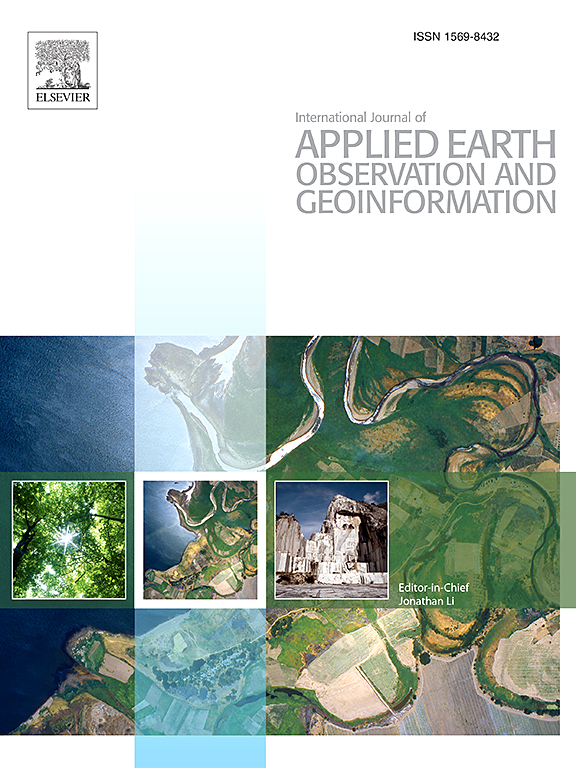Shape distortion analysis of hexagonal discrete global grid systems based on standard deviation of neighbor distance
IF 7.6
Q1 REMOTE SENSING
International journal of applied earth observation and geoinformation : ITC journal
Pub Date : 2025-06-16
DOI:10.1016/j.jag.2025.104660
引用次数: 0
Abstract
Hexagonal Discrete Global Grid Systems (HDGGS) are spatial reference frameworks based on the spatial discretization of the Earth’s surface, dividing it into a network of uniform hexagonal cells. They have been widely applied in geospatial analysis and environmental science fields. However, the hexagonal cells are not perfectly uniform, exhibiting inevitable shape distortion and area deformation. This study proposes a neighbor distance standard deviation method to characterize the shape deformation of individual hexagonal cells, and introduces a global deformation index to assess overall distortion magnitude, thereby addressing the limitations of deformation analysis based solely on cell area and perimeter differences. Finally, we experimentally analyzed deformation characteristics across three hexagonal discrete global grid systems projection types: Fuller3H, Fuller4H, ISEA3H, ISEA4H, and Uber H3. The experimental results show that, compared with ISEA-projection-based HDGGS grids, the Fuller-projection-based HDGGS grids’ cell neighbor distance standard deviation, grid neighboring distance standard deviation, and global deformation index are 72.09 % to 76.12 %, 74.25 % to 81.92 %, and 72.25 % to 76.29 % of the former’s values, respectively. In comparison, the Gnomonic-projection-based HDGGS’s global deformation index is 55.28 % and 40.35 % of the previous two’s values, respectively. Therefore, Gnomonic-projection-based HDGGS demonstrates the least cell shape deformation and optimal equidistant characteristics. This study pioneers quantifying local distance consistency as standardized neighbor distance standard deviation, transcending conventional evaluation paradigms that solely rely on cell perimeter mean squared error or compactness. Experimental results confirm the method’s effectiveness in quantitatively evaluating HDGGS shape deformation, providing a decision-support tool for HDGGS projection type selection.
基于邻距标准差的六边形离散全局网格系统形状畸变分析
六边形离散全球网格系统(HDGGS)是基于地球表面空间离散化的空间参考框架,将其划分为均匀六边形单元网络。它们在地理空间分析和环境科学领域得到了广泛的应用。然而,六边形单元并非完全均匀,呈现出不可避免的形状畸变和面积变形。本研究提出了一种邻距标准差法来表征单个六边形单元的形状变形,并引入了一种全局变形指数来评估整体变形程度,从而解决了仅基于单元面积和周长差异进行变形分析的局限性。最后,我们通过实验分析了三种六边形离散全局网格系统投影类型(Fuller3H、Fuller4H、ISEA3H、ISEA4H和Uber H3)的变形特征。实验结果表明,与基于isea投影的HDGGS网格相比,基于富勒投影的HDGGS网格的单元相邻距离标准差、网格相邻距离标准差和全局变形指数分别为前者的72.09% ~ 76.12%、74.25% ~ 81.92%和72.25% ~ 76.29%。相比之下,gnomon -projection-based HDGGS的全球变形指数分别为前两种方法的55.28%和40.35%。因此,基于gnomon投影的HDGGS具有最小的单元形状变形和最佳的等距特性。该研究率先将局部距离一致性量化为标准化的邻居距离标准差,超越了仅依赖于细胞周长均方误差或紧凑性的传统评估范式。实验结果验证了该方法定量评价HDGGS形状变形的有效性,为HDGGS投影类型选择提供了决策支持工具。
本文章由计算机程序翻译,如有差异,请以英文原文为准。
求助全文
约1分钟内获得全文
求助全文
来源期刊

International journal of applied earth observation and geoinformation : ITC journal
Global and Planetary Change, Management, Monitoring, Policy and Law, Earth-Surface Processes, Computers in Earth Sciences
CiteScore
12.00
自引率
0.00%
发文量
0
审稿时长
77 days
期刊介绍:
The International Journal of Applied Earth Observation and Geoinformation publishes original papers that utilize earth observation data for natural resource and environmental inventory and management. These data primarily originate from remote sensing platforms, including satellites and aircraft, supplemented by surface and subsurface measurements. Addressing natural resources such as forests, agricultural land, soils, and water, as well as environmental concerns like biodiversity, land degradation, and hazards, the journal explores conceptual and data-driven approaches. It covers geoinformation themes like capturing, databasing, visualization, interpretation, data quality, and spatial uncertainty.
 求助内容:
求助内容: 应助结果提醒方式:
应助结果提醒方式:


